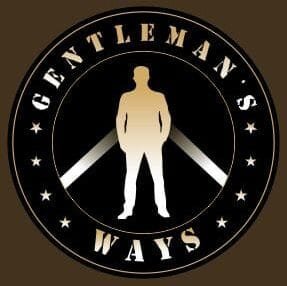Last updated on July 6th, 2025 at 03:55 pm
Men’s haircuts define your style and confidence. From fades to crew cuts, this ultimate guide breaks down every cut you need to know to look sharp and stay groomed.
Of course, you already know that a good haircut changes how you feel when you look in the mirror.
It sharpens your style, brings out your features, and sets the tone for how others see you.
But choosing the right one isn’t always easy. You’ve got fades, crew cuts, tapers, crops, and more, each with its purpose and feel.
Some haircuts work better with certain face shapes or hair textures, while others fit better with your lifestyle or routine.
This guide is built to help you make smarter choices at the barber’s chair.
You’ll get the clarity you need without the guesswork. If you’ve ever walked out of a haircut wishing you’d picked something else, this is where that stops.
Let’s help you find the right cut that works for you.
Recommended: 10 Best Hair Grooming Tools that Keep Men Sharp
What are Men’s Haircuts?
Men’s haircuts are the way hair is trimmed and shaped to create a structured look, focusing on length, edges, and overall form.
They determine the foundation of how your hair sits and grows out. This is different from men’s hairstyles, which deal with how the hair is arranged, styled, or textured after the haircut.
While a haircut sets the base, a hairstyle adds personality through products and styling techniques.
For example, a fade is a haircut, but styling it into a slick back or messy top creates the hairstyle.
Understanding this difference helps you choose better at the barber’s chair and communicate clearly about the look you want. See an in-depth post on men’s hairstyles here.
How to Choose the Right Haircut
A good haircut isn’t just about trends; it should fit your face shape, hair texture, lifestyle, and profession.
A style that looks sharp on one person might not suit another. To get the right cut, start with what suits you naturally, then communicate clearly with your barber for the best results.
Face Shape Matters
Your face shape plays a huge role in how a haircut looks on you. Certain cuts add balance, while others can emphasize or soften features.
From oval to rectangular, knowing what works for your structure makes a big difference.
Find a cut that complements your face rather than fighting against it.
- Oval: Balanced features mean most cuts look natural, classic or trendy styles work easily with this face shape.
- Round: Add volume at the top and keep sides short to create more vertical shape and reduce facial roundness.
- Square: Short, structured cuts highlight your strong jawline and keep your features defined without looking too blocky.
- Diamond/Triangle: Wider tops and layered styles add proportion by balancing out narrower foreheads and more angular cheekbones.
- Heart: Mid-length cuts with texture soften the pointy chin and avoid highlighting the forehead too much.
- Oblong/Rectangular: Choose fuller sides and avoid tall pompadours to prevent elongating the face more.
[Read the full guide to the best men’s haircuts for each face shape.]
Know Your Hair Type
Your hair type affects more than style; it controls how your haircut holds shape, reacts to products, and handles weather.
Whether your hair is straight, curly, fine, or thick, understanding your texture helps you pick a cut that fits how your hair behaves naturally and how much effort you want daily.
- Straight hair: Easy to style, but often lies flat and lacks natural body unless layered or textured properly.
- Wavy hair: Naturally adds movement and depth—works great with medium-length and relaxed hairstyles.
- Curly or coily hair: Has lots of volume and spring—requires structure to avoid puffiness or uneven shape.
- Fine hair: Tends to fall limp, so shorter cuts with blunt lines can help add the look of fullness.
- Thick hair: Can feel heavy, requires layering or thinning to avoid bulkiness and help hold shape longer.
Consider Your Lifestyle and Profession
The best haircut fits your life, not just your head. A cut that works for the office might not suit a creative field.
Daily grooming time, physical activity, and work expectations should shape your choice.
Pick a cut you can manage easily and that fits where and how you live.
- Formal careers: Office jobs call for clean, conservative cuts like crew cuts, tapers, and classic side parts.
- Creative roles: These environments allow more relaxed or artistic styles, from textured crops to longer, styled hair.
- Low-maintenance cuts: If you don’t want to style daily, go for buzz cuts, short fades, or simple tapers.
- Active lifestyles: Choose cuts that stay clean during workouts, like close fades or cropped textured styles.
- Style upkeep: Trendy styles demand daily grooming. Don’t choose high-maintenance cuts if you lack time or tools.
[More on balancing your haircut with lifestyle and work demands.]
Talk to Your Barber Clearly
Knowing what to say makes all the difference at the barbershop. Don’t just say “short”—be specific with terms and pictures.
Your barber understands haircut language, and you should too. Speak, use clipper guard numbers, know your neckline options, and don’t be afraid to ask questions until you’re sure.
- Hard part and texture: These add polish. A shaved part line or layered texture can define your cut. [Read our full “How to Talk to Your Barber” post.]
- Use clipper guards: Saying “#2 on the sides” tells your barber exactly how short you want your fade.
- Bring photos: A visual reference reduces miscommunication and helps your barber see your exact style preference.
- Ask for details: Mention if you want a fade, taper, undercut, or anything specific for your neckline or crown.
- Neckline types: Decide between tapered, rounded, or blocked—each changes how neat or natural your haircut looks.
Related Posts
- Fashion Guide for Men
- Haircuts and Styles for Black Men
- The Dreadlocks Hairstyle and How to Grow It
- Tips for Taking Care of Your Scalp
- The Buzz Cut Taper Men’s Hairstyle
- Mastering Men’s Hair Care Routine
- Introduction to Proper Grooming for Men
- Older Men’s Hair Styles
Types of Men’s Haircuts
Every haircut starts with structure. Before styling, fading, or adding product, you need a solid base.
That’s where haircuts come in. Choosing the right one depends on your hair type, face shape, and how you want to look day to day.
From classic cuts to modern shapes, each style offers something different.
Below are the most popular types of men’s haircuts, broken down to help you make the right choice.
Buzz Cut
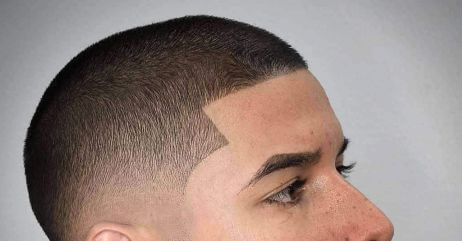
The buzz cut keeps things simple and sharp. It’s done using clippers, trimming your hair down to a uniform length all over your head.
You can ask for different clipper guards, depending on how short you want it. This cut is ideal for men with strong facial features or an active lifestyle.
It’s easy to clean, requires no styling products, and gives you a clean look every day.
Buzz cuts also work well for thinning hair or receding hairlines, drawing attention to your eyes and face shape.
If you’re looking for a no-nonsense haircut that stays neat without effort, this is your go-to.
It fits in any setting, gym, office, or weekend hangout, and suits nearly all face shapes. For many men, it’s the first cut that teaches how less can do more.
See an in-depth post on buzz cut here.
Crew Cut
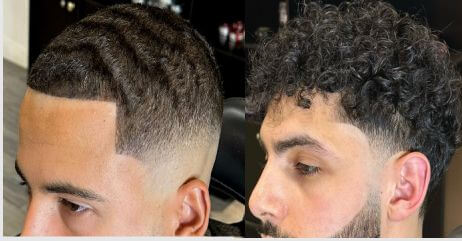
The crew cut gives you short sides and a slightly longer top, which adds shape without the need for daily styling.
It’s one of the most balanced and adaptable men’s haircuts. You can wear it as-is or add a little product for extra control or texture.
The top is usually styled forward or up, giving you just enough length to play with. Barbers usually taper or fade the sides, so the whole cut looks clean and defined.
Crew cuts are especially good if you want something formal but still low effort.
They suit oval, square, and heart-shaped faces, and they work for straight, wavy, or thick hair.
Whether you’re heading to a meeting or out for drinks, this cut keeps you looking sharp without trying too hard. See an in-depth post on crew cut here.
Ivy League
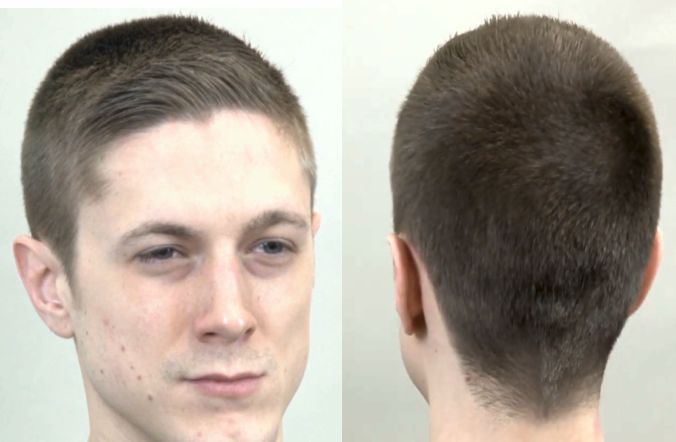
The Ivy League cut lets you keep a bit more length while still looking well-groomed. It’s a smart pick if you want a traditional style with a little flexibility.
The top is long enough to part to the side or brush back, while the sides are kept short with scissors or a low fade.
This haircut brings a clean and academic look that feels professional but not stiff.
It works best with straight or slightly wavy hair and is easy to maintain with regular trims.
If you wear suits or work in business settings, the Ivy League helps you stay polished without losing your edge.
It pairs well with a defined hairline and subtle product use. You can keep it formal during the week and wear it looser on the weekends.
French Crop

The French crop is clean and contemporary. It features a cropped fringe at the front with short sides and back, often faded or tapered.
The top is textured and cut short, making it easy to manage with minimal styling.
This cut puts focus on the forehead and eyes, making it great for guys with a round or oval face shape.
It’s especially helpful if you have thinning hair or a receding hairline, as the fringe helps conceal the hairline while adding volume up front.
You can wear it neat or tousled, depending on your mood.
It requires only a touch of product to keep the shape, and it works well if you’re going for an effortless look.
The French crop blends clean lines with casual texture, good for everyday wear without sacrificing edge.
Caesar Cut
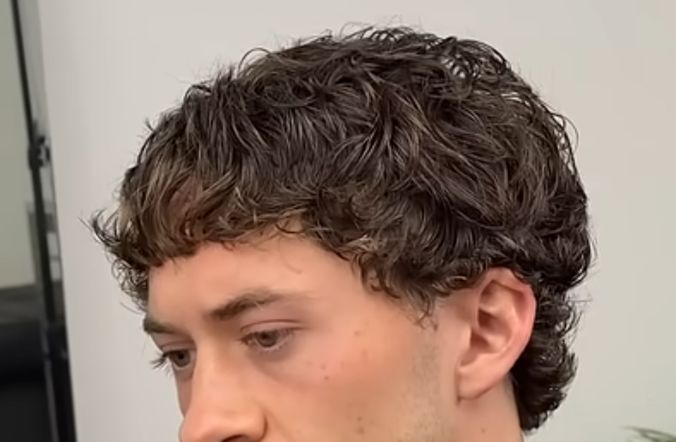
The Caesar cut features short hair all around with a forward-swept fringe. The cut’s simplicity and straight lines give it a structured, timeless appearance.
It suits men who want a neat, reliable haircut that doesn’t require much maintenance.
Originally made famous by Julius Caesar, this style works especially well for men with prominent foreheads or thinning crowns.
The length is usually the same across the top, sides, and back, but modern versions add slight fading or texture for more dimension.
It’s ideal for coarse or straight hair, and it looks sharp even without styling products.
If you like a symmetrical cut with historical roots and modern appeal, the Caesar might be what you’re looking for.
It’s bold in its simplicity and pairs well with strong facial features.
High and Tight
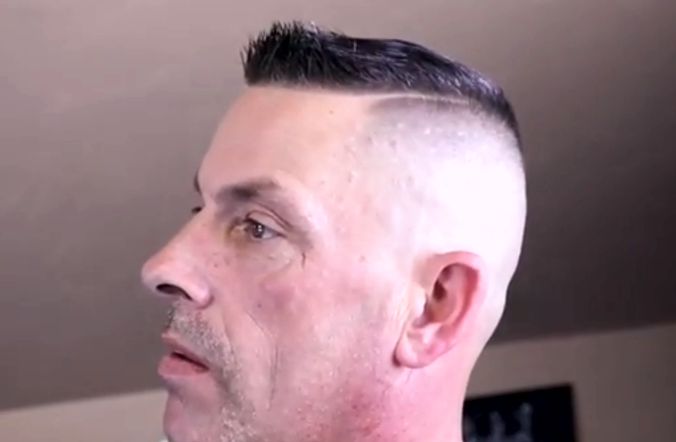
The high and tight is sharp, strict, and unmistakably masculine. Borrowed from military grooming standards, this haircut leaves the top very short while taking the sides down to the skin or near-skin level.
It keeps your head cool, your style tidy, and your maintenance minimal. There’s little to no blending between the top and sides, cutting a bold, clean contrast.
Best suited for square or oval faces, the high and tight can make your jawline look more defined.
It works well if you have a strong bone structure or just want something clean-cut without hassle. Great for summer or active lifestyles, this cut is about function and confidence.
With regular trims, it stays sharp all week without needing combs or products.
Flat Top
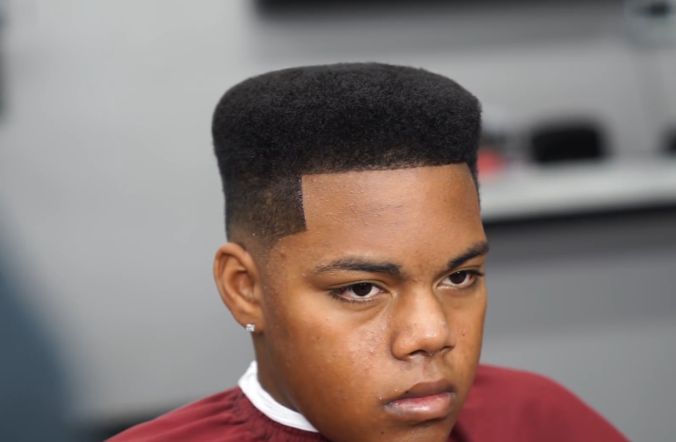
The flat top is structured, sharp, and unmistakable. It’s defined by a flat horizontal top that stands upright, with sides that taper tightly down.
Popular in the 80s and 90s and still turning heads today, the flat top works best with thick or coarse hair that can hold shape.
It suits men who want to stand out and don’t mind keeping the lines clean.
This cut is best maintained with regular barber visits to keep the top level and the angles precise.
It goes well with square or round face shapes, especially if you want to add height or balance out your features.
Whether you want to go retro or bold, the flat top brings a strong personality and clean geometry to your haircut game.
Regulation Cut
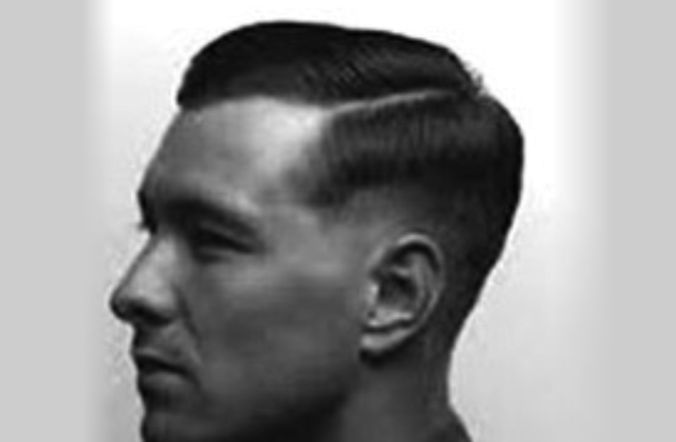
The regulation cut is structured, neat, and easy to maintain. It’s a traditional military haircut with short sides and a slightly longer top, often styled with a part.
This cut has been around for decades and is trusted by men who value consistency and polish.
The top can be combed to the side or slicked back, and the sides are usually tapered or faded for a clean finish.
It works especially well for straight or wavy hair and flatters oval and square face shapes.
The regulation cut fits into any setting, office, casual, or formal, making it a smart choice if you like to keep your style sharp and understated.
It sends a message of discipline and order without looking stiff.
Taper Cut
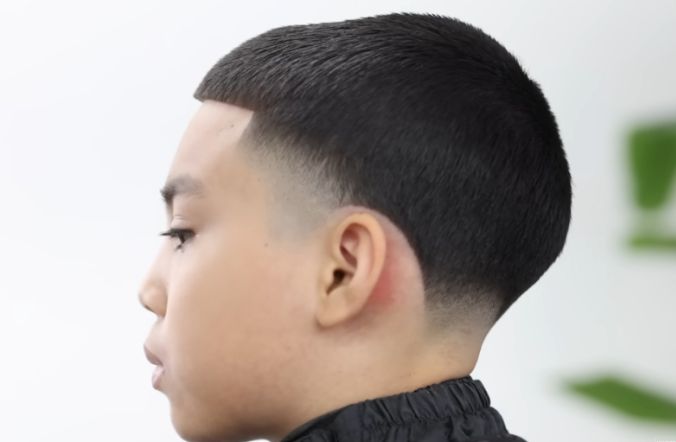
The taper cut keeps things clean without going too short. It features a gradual reduction in hair length from the top down to the sides and neckline, creating a smooth and blended look.
Unlike a fade, a taper leaves more length around the ears and nape, making it less dramatic but more natural.
This style works well with straight, wavy, or curly hair and can be combined with many top styles, from side parts to textured crops.
If you want something classic that fits both formal and relaxed settings, a taper cut gives you that flexibility.
It’s great for first-time haircut changes because it doesn’t require a bold leap.
Barbers can adjust the taper to be subtle or more defined based on your preference.
With regular trims, this cut stays tidy without demanding daily styling.
Fade Cuts
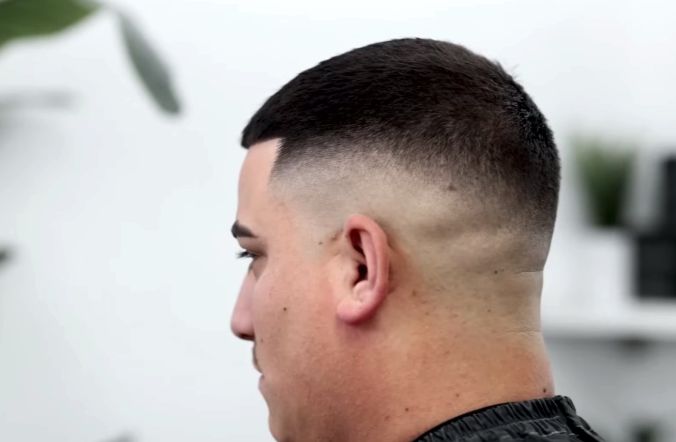
Fade cuts are all about clean transitions. They involve gradually shortening the hair from the top of your head down to the sides and back, blending the lengths smoothly. Fades come in three main types:
- Low fade starts just above the ears for a subtle finish
- Mid fade begins around the temple for a balanced look
- High fade starts higher up and creates bold contrast
Fades pair well with almost any top style, from buzz cuts to pompadours. The skin fade variation goes right down to bare skin at the bottom, making the cut even sharper.
Barbers often combine fades with line-ups, hard parts, or designs for more detail.
Fades require frequent touch-ups to stay fresh but reward you with a clean edge that sharpens your whole look.
No matter your hair type or face shape, there’s a fade that fits your style.
Undercut
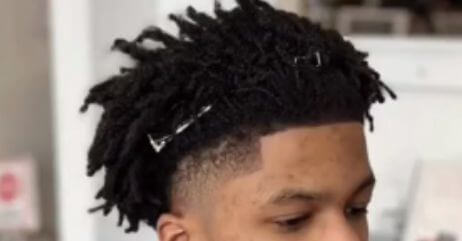
The undercut keeps the top long while taking the sides and back very short. What makes it different from a fade or taper is that there’s no gradual blend; the difference in length is clear and bold.
This haircut works great for guys who like contrast and want to style their top hair in different ways.
You can slick it back, let it fall forward, or wear it messy. It suits straight and wavy hair best, but can be adjusted for thick or curly textures too.
The undercut draws attention upward, which is great if you want to highlight your face or beard.
It’s modern and edgy, but still wearable in formal spaces, depending on how you style the top.
The key to pulling it off is keeping the lines sharp and the top trimmed to a manageable length.
Scissor Cut
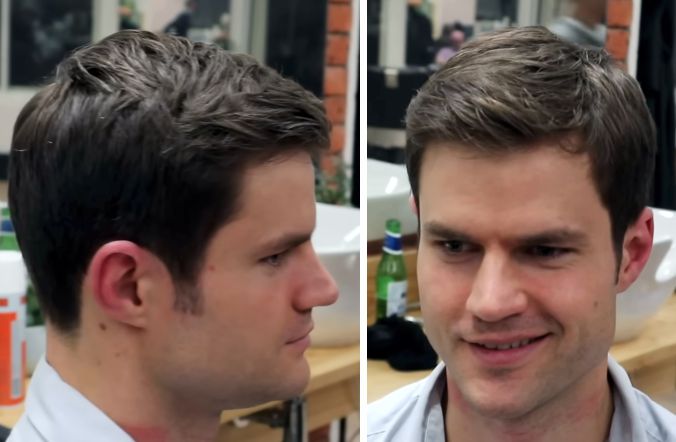
The scissors cut is all about control, texture, and natural shape. Instead of clippers, your barber uses scissors to shape the entire haircut.
This technique creates soft edges and allows for more layering, making it perfect for medium to long hair.
It’s ideal if you want movement, volume, or a laid-back style that still looks sharp.
Scissor cuts work with all hair types and are especially good if your hair is fine, wavy, or curly. They allow the cut to follow your head shape and grow out more evenly.
If you’re not into harsh lines or extreme contrasts, the scissor cut gives a more lived-in, polished look.
It also gives barbers more freedom to personalize the cut to your features and lifestyle.
This is the kind of haircut that ages well and adapts to change without needing constant upkeep.
Types of Fades and Fade Levels
A fade is a cutting technique where your hair transitions from longer at the top to shorter down the sides and back. The sharpness and level of that transition define the fade type. The three most common fade levels are:
- Low fade: Starts just above the ears and curves around the hairline. It offers a subtle, clean finish.
- Mid fade: Begins midway between the temples and ears. It balances boldness with a neat appearance.
- High fade: Starts above the temples and creates a dramatic contrast between the top and sides.
Fades can also be skin fades, where the shortest part is shaved down to the skin.
You can combine fades with other styles like pompadours, French crops, or textured tops.
This cutting method gives your haircut more shape, definition, and edge, especially when cleaned up regularly at the barber.
What Are Hard Parts?
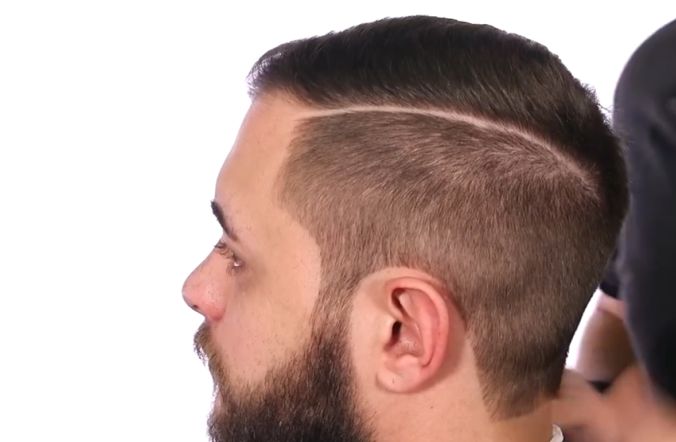
A hard part is a clean, shaved line cut into your scalp along your natural parting. Barbers usually create it with a razor or trimmer to define the part more clearly.
Unlike a natural part, which you style in with a comb, a hard part is cut into place and adds sharp contrast and structure to your hairstyle.
Hard parts are commonly paired with hairstyles like side parts, pompadours, or comb-overs, and they’re ideal for men who want a bold, modern look.
While they make your parting easier to style, they do require upkeep. Since the shaved line grows out quickly, you may need a touch-up every couple of weeks to keep it sharp.
If you want a clean and structured appearance with minimal daily effort in parting your hair, a hard part is worth trying.
Just make sure it fits your face shape, hair type, and lifestyle before committing.
Hairline Types
Your hairline plays a major role in how your haircut looks. There are a few common types of hairlines:
- Straight hairline: Even across the forehead, and common in younger men. It suits sharp styles like buzz cuts or crew cuts.
- Widow’s peak: A V-shaped point in the center of the forehead. Works well with side parts, fades, or longer fringe styles.
- Rounded hairline: Curves naturally around the forehead and is often seen with softer styles.
- Receding hairline: Hair thins or pulls back around the temples. Clean cuts like close fades or buzz cuts can make it less noticeable.
A good barber knows how to cut around your hairline to either define or soften it, depending on your preference.
Some men also choose to edge up their hairline for a more defined shape.
Knowing your natural hairline helps you pick styles that frame your face and age well with minimal touch-up needs.
Taper vs Fades
Though taper and fade are often used interchangeably, they’re not the same. A taper is a gradual decrease in hair length around the neckline and sideburns.
It’s subtle and blends naturally into longer hair. Tapers are often seen in more traditional or formal haircuts like the Ivy League or scissor cuts.
A fade, on the other hand, is a sharper transition that can start low, mid, or high on the head. The contrast is more noticeable, and the fade can go down to the skin.
It gives a bolder, more modern look and is common in buzz cuts, undercuts, and textured crops.
If you want a clean yet understated haircut, go with a taper. If you prefer something edgier or more defined, a fade works better.
Both styles need regular maintenance, especially if you like keeping the lines sharp and the transitions smooth.
Maintenance and Styling Tips for Men’s Haircuts
A good haircut looks even better when you know how to maintain it. Keeping your haircut sharp means paying attention to what you use, how you care for it, and when to trim it.
Choose the Right Shampoo and Conditioner
Your haircut starts with clean, healthy hair. If you have thick or curly hair, go for a moisturizing shampoo and conditioner.
It keeps your hair soft and easy to manage. If your hair is fine or flat, a volumizing formula helps give it body without weighing it down.
Always check that your products match your hair type; this simple step keeps your cut in shape longer and makes styling easier.
Use the Right Styling Products
What you put in your hair changes how your haircut looks. Use pomade or wax for a sleek or textured style.
Creams work well if you want a natural, soft finish. Apply to damp hair if you want control and shine. Use it on dry hair if you want extra hold and definition.
A little goes a long way; you don’t need much to keep things in place.
Invest in Basic Styling Tools
The right tools help you make the most of your cut. Use a wide-tooth comb to detangle wet hair gently.
A round brush adds volume when used with a blow dryer. A vent brush speeds up drying and helps create natural flow.
Even simple tools like a fine-tooth comb can help define parts and edges.
Keep your tools clean and use them based on your hair length and texture.
Schedule Regular Trims
Even the best haircut loses shape over time. Book a trim every four to six weeks to keep the edges clean and the shape tight.
If you wear a fade or undercut, you may need a touch-up every two to three weeks.
Longer styles can go a little longer, but regular trims stop split ends and keep the overall look neat. Watch how your hair grows and adjust
Common Men’s Haircuts Mistakes to Avoid
A fresh cut can quickly lose its charm if you make simple yet costly mistakes.
From unclear instructions to choosing styles that don’t suit your hair or lifestyle, here are the key errors that can ruin an otherwise good haircut.
Not Communicating Clearly with the Barber
If you don’t describe what you want properly, you’ll likely walk out disappointed.
Use guard numbers, bring reference photos, and ask about terms like fade, taper, and neckline.
A clear conversation always leads to better, more accurate results.
Choosing a Cut That Fights Your Hair Texture
Ignoring your natural hair texture creates daily styling frustration. Straight hair won’t hold waves, and thick curls need shape control.
Pick a cut that complements your natural growth, not one that forces constant maintenance or products to stay in place.
Letting Too Much Time Pass Between Trims
Even the best haircut loses shape when neglected. Overgrown sides, messy edges, and split ends make your style look sloppy.
Keep your cut fresh with regular visits, usually every 3 to 5 weeks, depending on how fast your hair grows.
Trying Trending Styles Without Personal Fit
Trendy cuts don’t work for everyone. What looks good on a celebrity might clash with your face shape, job, or lifestyle.
Always consider your hair type, profession, and grooming habits before following social media styles that aren’t made for you.
Troubleshooting Common Haircut Issues
Not every haircut turns out how you expect, and sometimes your hair has a mind of its own. Here’s how to fix and manage common problems.
Dealing with Cowlicks, Thinning Hair, or Receding Hairlines
Cowlicks don’t disappear; you work with them. Let your barber cut in the direction your hair grows, not against it. Thinning hair?
Ask for shorter, fuller styles that don’t cling to the scalp. If you’re dealing with a receding hairline, go for cuts that add height on top and blend the temples.
Avoid combovers or heavy styles that draw attention to thinning spots. The right haircut can make problem areas easier to manage.
Fixing a Bad Haircut
A bad haircut isn’t the end; it’s just a lesson. Don’t panic or try to fix it yourself. Go back to your barber or see another one for adjustments.
A clean-up cut can improve uneven layers or blend sharp fades. If the cut is too short, focus on styling products and hats while it grows out.
Next time, bring photos, speak clearly, and give feedback as the cut happens. Communication prevents repeat mistakes.
Solutions for Common Scalp Issues (Dryness, Dandruff, etc.)
Dry scalp and flakes can ruin the look of even the sharpest haircut. Switch to a sulfate-free shampoo and use a moisturizing conditioner regularly.
Don’t overwash; two or three times a week is enough for most men.
If dandruff persists, use a medicated shampoo and avoid heavy products that clog the scalp.
Keep your hair clean and your barber tools sanitized. Healthy scalp, healthy cut, what’s under your hair matters just as much as the style.
Barbershop Etiquette and Communication
Getting the haircut you want isn’t just about sitting in the chair. It starts with finding the right barber and knowing how to speak their language.
How to Find a Skilled Barber or Stylist
Not every barber will understand your style or hair type. Look for someone who works with hair textures like yours and shows consistent results.
Ask friends with great cuts for referrals or check local barbershop reviews online.
Pay attention to how clean the shop is, how the barber handles clients, and whether they take time to listen.
A skilled barber is part craftsman, part listener, and finding one can change your grooming experience.
Key Terms to Know When Describing Your Desired Haircut
Barber terms help you speak clearly and avoid surprises. Know the difference between a fade and a taper.
Learn what clipper guard numbers mean, saying “a number 2 on the sides” is clearer than saying “short.”
Understand terms like neckline types, texturizing, and hard parts.
The more familiar you are with basic terms, the easier it is to explain your style without confusion.
This makes your barber’s job easier and your cut better.
Tips for Effective Communication to Get the Haircut You Want
Don’t sit down and hope for the best. Bring photos of the haircut you want from different angles.
Explain how you style your hair daily; this helps the barber adjust the cut to your routine. Be honest about past cuts you didn’t like and mention what worked.
Use clear, direct words instead of vague ones like “just a little.” Speak up during the cut if something feels off; it’s easier to fix early.
Tipping and Building a Relationship with Your Barber
A good relationship with your barber goes beyond one appointment. Tip at least 15 to 20 percent if you’re happy with the service.
Say thank you and be consistent with your visits. Over time, your barber learns your hair’s behavior, your preferences, and how to fine-tune the cut.
Loyalty builds trust, and trust leads to better results. You’re not just paying for a haircut, you’re building a connection with someone who keeps you sharp.
Cultural Influences on Men’s Haircuts
Men’s haircuts have always carried meaning. From traditional symbols to modern fashion, what you wear on your head reflects more than personal taste—it shows culture, history, and identity.
Tribal Roots and Traditional Beliefs
In many Indigenous communities, your haircut tells a story. It can show your age, tribe, or even your role in society.
A shaved head might reflect mourning, while long hair can represent strength or spiritual connection.
These styles are more than just grooming; they are worn with pride, passed through generations, and tied to heritage. You’re not just styling hair, you’re carrying a legacy that speaks louder than words.
Historical Status and Social Structure
In places like ancient China and Korea, haircuts signaled your position in society.
Wearing a topknot wasn’t just fashion; it meant you respected order and culture. Samurai in Japan wore the Chonmage for function and honor.
These weren’t random choices. Your hairstyle told people who you were and what you stood for.
Even now, classic cuts carry echoes of structure, tradition, and discipline.
Global Trends and Cultural Mixing
As fashion and media connect the world, haircuts have become more blended. You’ll find fades in Paris, undercuts in Tokyo, and textured crops in Lagos.
These styles didn’t just spread, they evolved. Influencers, musicians, and athletes helped turn local cuts into global looks.
When you pick a style today, you’re likely blending bits of different cultures, and your hair becomes a map of shared trends and borrowed inspiration.
Masculinity and Modern Identity
How you wear your hair can reflect how you see yourself as a man. In the past, some styles were off-limits because they looked “too soft” or “too bold.”
But today, more men are trying longer styles, dyed hair, or designs that used to be boxed into stereotypes.
Haircuts now challenge old ideas about masculinity. You get to choose what fits you, not what fits a label.
Frequently Asked Questions
How often should men get a haircut?
Short haircuts like fades or buzz cuts need trimming every 4 to 6 weeks. Longer styles can go 8 to 12 weeks between cuts.
How do I describe my haircut to the barber?
Tell your barber the clipper numbers, describe the length on top and sides, mention fades or tapers, and show a reference photo if possible.
Which haircut suits my face shape?
Match your haircut to your face shape. Round faces need height, square faces suit sharp lines, and oval faces work with most classic cuts.
Can my hair texture pull off this cut?
Hair texture affects results. Curly, fine, thick, or wavy hair all behave differently. Ask your barber what suits your hair’s natural movement and density.
What products and tools help maintain my haircut at home?
Use styling products like pomade or wax, a blow dryer, and combs that suit your hair type. Ask your barber for personalized recommendations.
What tools and products keep my haircut sharp?
Use a quality trimmer, styling comb, matte pomade or cream, shampoo, and a boar-bristle brush to maintain shape, texture, and cleanliness daily.
Conclusion
Men’s hairstyles play a significant role in shaping one’s overall appearance and self-expression.
We have explored various men’s haircuts and styles, highlighting their versatility and ability to reflect personal style and preferences.
It is crucial to understand the importance of selecting a haircut that aligns with your personality and lifestyle.
Additionally, we encourage you to step out of your comfort zone and experiment with different styles to discover new looks that enhance your confidence and individuality.
Remember to seek professional advice, consider maintenance requirements, and most importantly, have fun with your hair.
Embrace the power of a well-chosen haircut and let it be a reflection of your unique identity.
References:
Pious Clements, an influential and experienced writer, is prolific on social issues and challenges prevailing gender roles on his website, “The Conducts of Life”. With an unwavering commitment to inclusivity and equality, Pious fearlessly unpacks societal norms and sheds light on the overlooked complexities.
His eloquent analyses and thought-provoking articles make him a trusted voice amplifying narratives that have long been silenced. Join Pious on his journey as he strives to reshape the world, one word at a time.
